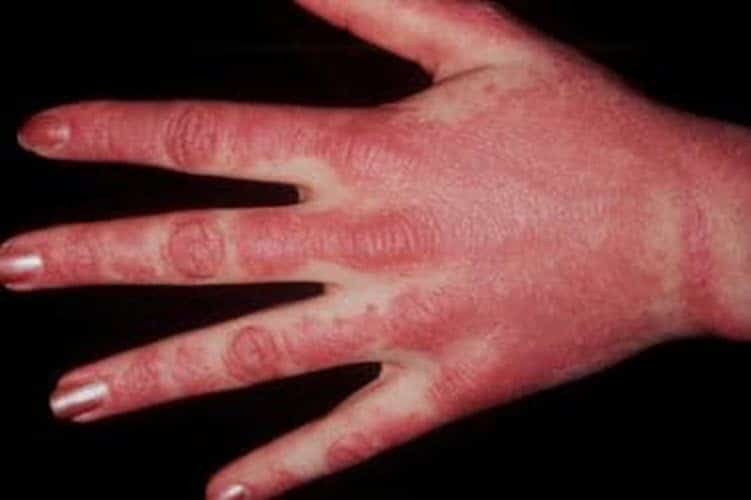All About Dermatomyositis: Causes, Symptoms and Treatment

Dermatomyositis is a rare disease that causes muscle weakness and rashes on your skin. It’s a form of myopathy. It can also cause severe symptoms that affect your ability to breathe and swallow.
Dermatomyositis is a form of polymyositis that affects your skin in addition to your muscles. See your provider right away if you experience any symptoms of dermatomyositis. Some cases take months to develop, but dermatomyositis can develop quickly. The sooner you begin treatment, the more likely it is you can avoid having severe complications.
In rare cases, dermatomyositis can be fatal, especially in the first year after symptoms start. It can also increase your risk of developing certain kinds of cancer.
Causes of Dermatomyositis
The cause of dermatomyositis is unknown, but the disease has much in common with autoimmune disorders, in which your immune system mistakenly attacks your body tissues. Genetic and environmental factors also might play a role. Environmental factors could include viral infections, sun exposure, certain medications, and smoking.
Symptoms of Dermatomyositis
The most common symptoms of dermatomyositis are muscle weakness and a rash on your skin.
Some people notice muscle weakness and a rash around the same time. You might have one symptom for weeks, months or even years without the other.
Muscle weakness might make it hard for you to do common motions, including:
- Sitting upright.
- Getting up from a seated position (like standing up from a chair or couch).
- Climbing stairs.
- Getting up after lying down.
- Washing your hair.
Dermatomyositis may cause a rash on your skin (especially on parts of your body exposed to the sun). Areas with a rash will be discolored and might be swollen. The most common locations include:
- Eyelids and around your eyes.
- Chest and the front of your shoulders (sometimes referred to as a v-sign rash).
- Neck and the back of your shoulders (a shawl sign rash).
- Scalp.
Other symptoms of dermatomyositis include:
- Discoloration and bumps (sometimes referred to as Gottron papules) on your hands, especially near your knuckles.
- Calcium deposits under your skin, in your muscles or in your connective tissue.
- Bumps on your knees or elbows.
- Ragged cuticles and prominent blood vessels on your fingernail folds.
- Joint pain.
Some people (especially kids) diagnosed with dermatomyositis grow out of it and never have symptoms again. However, 80% of cases are chronic (they come back over time) and cause lifelong symptoms.
Diagnosis and Tests
Dermatomyositis is usually diagnosed with blood tests and biopsies of your skin and muscles.
Your provider will test your blood for:
- Increased amounts of specific muscle enzymes that means something is damaging them.
- Autoantibodies (cells that show your immune system is reacting to something it detects as harmful).
You’ll also need a skin biopsy of any rashes. Your provider might also biopsy your muscles to confirm inflammation inside them.
You might need one of a few imaging tests. Your provider will use these to evaluate your muscles, nerves, lungs and other organs. These tests can help them determine if your symptoms are caused by dermatomyositis or another issue. The most common imaging tests used to diagnose dermatomyositis include:
- Magnetic resonance imaging (MRI).
- Chest X-rays.
In some cases, your provider may request an electromyography (EMG). This test measures electrical activity in response to muscle or nerve stimulation.
Around 15% of people with dermatomyositis develop cancer later in their life. Some of the most common cancers people with dermatomyositis develop include:
- Ovarian cancer.
- Lung cancer
- Lymphoma
- Breast cancer
- Colon cancer
How is dermatomyositis treated?
Dermatomyositis treatments include:
- Corticosteroids: Corticosteroids will decrease the inflammation in your muscles.
- Physical therapy: Physical therapy (and exercise in general) can help rebuild damage in your muscles. The stronger your muscles are, the better equipped they are to handle any damage from dermatomyositis.
- Immunosuppressant medicines: Immunosuppressants stop your immune system from damaging healthy cells and tissues. They can slow down any damage your body’s defenses are causing in your muscles.
- Intravenous immunoglobulin (IVIg): IVIg is an infusion of extra immunoglobulin, a naturally occurring element of your blood’s plasma. IVIg treatments can work alongside immunosuppressants, or as an alternate treatment.
- Speech therapy: If you have muscle weakness in or around your throat, speech therapy can help you strengthen the muscles in your throat that help you swallow.
Which treatments you need depends on where you’re having symptoms, and how severe they are. Talk to your provider about what to expect and when you’ll need certain treatments.
Observer Voice is the one stop site for National, International news, Sports, Editor’s Choice, Art/culture contents, Quotes and much more. We also cover historical contents. Historical contents includes World History, Indian History, and what happened today. The website also covers Entertainment across the India and World.

